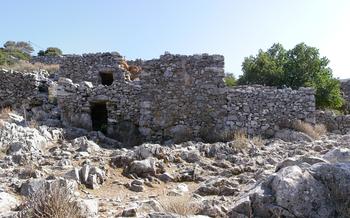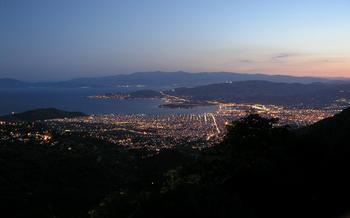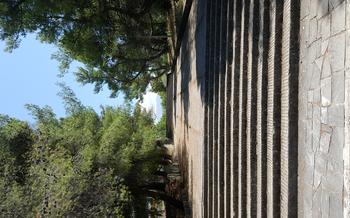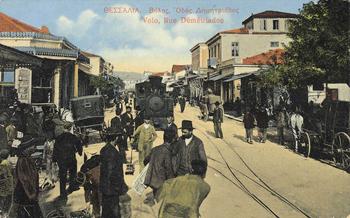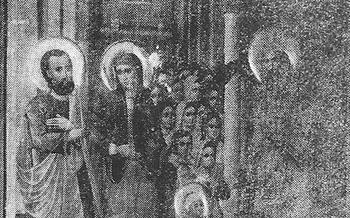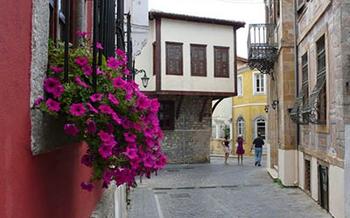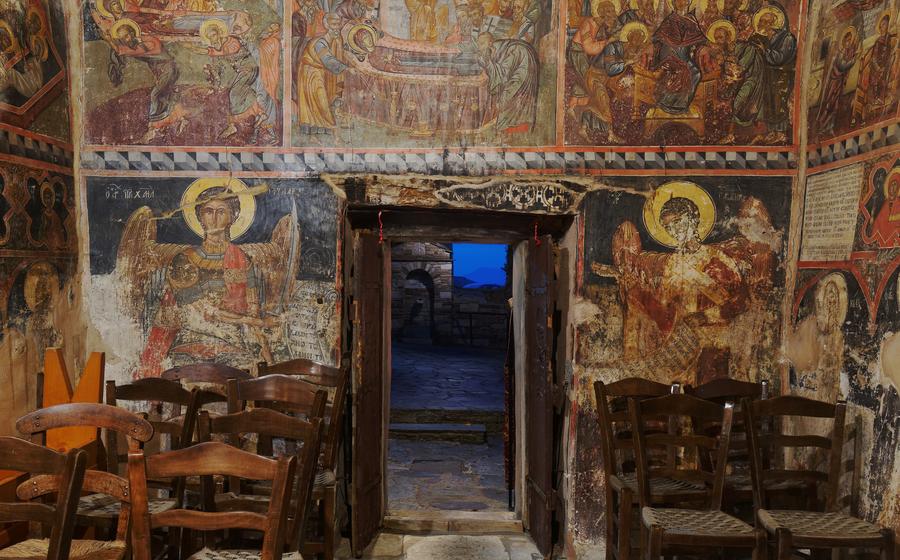
Panagia Portarea Church
- The Panagia Portarea Church: A Historical and Architectural Gem
- Location: A Picturesque Setting by the Sea
- History: A Tale of Faith, Miracles, and Resilience
- Architecture: A Blend of Byzantine and Post-Byzantine Styles
- Interior: A Realm of Sacred Art and Symbolism
- Highlights: Unmissable Features of the Church
- Religious Significance: A Center of Orthodox Devotion
- Visiting the Church: Practical Information and Tips
- Things to Do Nearby: Exploring Volos and Beyond
- Photography and Social Media: Capturing the Beauty of the Church
- Accessibility: Ensuring an Inclusive Experience
- Local Traditions and Customs: Respecting the Culture
- Local Cuisine: Indulging in Greek Delights
- Insider Tip: Discovering Hidden Gems
The Panagia Portarea Church: A Historical and Architectural Gem
In the heart of Volos, Greece, stands the Panagia Portarea Church, a magnificent testament to Byzantine and post-Byzantine architecture. Built in the 13th century, this church holds immense historical significance as a place of worship, a cultural landmark, and a symbol of religious devotion. With its awe-inspiring architecture, intricate frescoes, and miraculous tales, the Panagia Portarea Church captivates visitors with its spiritual essence and rich history.
The church's unique architectural features set it apart from other religious structures in the region. Constructed using local stone, the church boasts arched windows, intricate carvings, and a central dome that dominates the skyline. The interior is equally breathtaking, featuring a spacious layout adorned with vibrant frescoes, an elaborate iconostasis, and intricate wood carvings. The harmonious blend of Byzantine and post-Byzantine styles creates a mesmerizing visual experience, showcasing the architectural prowess of its creators.
Beyond its architectural splendor, the Panagia Portarea Church holds immense cultural and religious significance. As a center of Orthodox devotion, the church attracts pilgrims from around the world who come to pay homage to the miraculous icon of the Panagia Portarea, believed to possess healing powers. The church also plays a vital role in the religious traditions of Volos, hosting festivals and celebrations honoring the Virgin Mary throughout the year. Its enduring presence amidst historical challenges has made it a symbol of resilience and continuity for the local community.
Location: A Picturesque Setting by the Sea
The Panagia Portarea Church is strategically situated in the picturesque city of Volos, Greece. Its prime location by the sea offers visitors breathtaking views of the captivating Pagasetic Gulf. The church stands proudly along the vibrant Volos waterfront, inviting both locals and tourists to immerse themselves in its historical and spiritual charm.
A visit to the Panagia Portarea Church is easily accessible by foot, allowing visitors to leisurely stroll through the city's charming streets and soak in the vibrant atmosphere. For those arriving by car, ample parking is available nearby, ensuring a hassle-free visit. Additionally, public transportation options, such as buses and taxis, provide convenient access to the church, making it easily reachable for visitors from all corners of the city.
The church's integration with the surrounding urban landscape is seamless, creating a harmonious blend of history and modernity. Its proximity to other notable landmarks, such as the Archaeological Museum of Volos and the Volos City Hall, invites visitors to create a comprehensive cultural itinerary, exploring the city's rich history and diverse attractions.
Whether you choose to wander on foot, drive, or take public transportation, the Panagia Portarea Church is effortlessly accessible, promising a memorable and enriching experience for visitors of all backgrounds.
History: A Tale of Faith, Miracles, and Resilience
The origins of the Panagia Portarea Church can be traced back to the Byzantine era in the 13th century. According to local tradition, the church was built on the site of an ancient temple dedicated to the goddess Artemis. Over the centuries, the church has undergone several renovations and expansions, reflecting the changing architectural styles and the devotion of the local community.
Miraculous events and legends are deeply intertwined with the history of the Panagia Portarea Church. One of the most famous stories is the miraculous intervention of the Virgin Mary during a fire that threatened to destroy the church. According to legend, the Virgin Mary appeared and extinguished the flames, saving the church from destruction. This event further solidified the belief in the miraculous powers of the Panagia Portarea icon.
Despite its religious significance, the church faced numerous challenges throughout history. During the Ottoman rule of Greece, the church was converted into a mosque, but it was eventually returned to the Orthodox Christian community after Greece regained its independence. The church also survived several natural disasters, including earthquakes and fires, which left their mark on the building but did not diminish its importance as a sacred site.
In recent years, the Panagia Portarea Church has undergone extensive restoration efforts to preserve its historical and architectural integrity. These efforts have included the restoration of the frescoes, the repair of the stonework, and the installation of new lighting systems. The church's resilience and its ability to endure through centuries of challenges stand as a testament to the deep faith and devotion of the local community.
Architecture: A Blend of Byzantine and Post-Byzantine Styles
The Panagia Portarea Church stands as a testament to the fusion of Byzantine and post-Byzantine architectural styles. Its exterior exudes a sense of solidity and grandeur, with stone construction forming the foundation of the church. Arched windows and intricate carvings adorn the facades, adding a touch of elegance and artistry to the overall structure.
Stepping inside the church, visitors are greeted by a spacious layout that allows for a sense of tranquility and reverence. A central dome, a characteristic feature of Byzantine architecture, crowns the interior, creating a sense of height and grandeur. The walls and ceilings are adorned with vibrant frescoes, depicting biblical scenes and saints with remarkable detail and artistry.
The iconostasis, a prominent feature of Orthodox churches, separates the sanctuary from the nave. It is intricately carved with scenes from the life of Christ and the Virgin Mary, showcasing the exceptional craftsmanship of the artisans who created it. Other decorative elements, such as mosaics, wood carvings, and intricate metalwork, add to the visual richness of the interior, creating a harmonious blend of Byzantine and post-Byzantine influences.
Interior: A Realm of Sacred Art and Symbolism
Stepping inside the Panagia Portarea Church is like entering a realm of sacred art and symbolism. The walls and ceilings are adorned with exquisite frescoes, each depicting a biblical scene or a saint. The vibrant colors and intricate details of these frescoes bring the stories to life, creating a sense of awe and inspiration.
Mosaics, with their shimmering tesserae, add another layer of beauty and symbolism to the church's interior. They depict religious figures, patterns, and scenes from the Bible, adding to the rich visual tapestry of the church.
Elaborate wood carvings, iconography, and other decorative elements further enhance the interior's sacred atmosphere. The iconostasis, a wall of icons that separates the sanctuary from the nave, is particularly impressive, featuring intricate carvings and a row of finely painted icons.
Each element of the church's interior has a symbolic meaning, reflecting the beliefs and traditions of Orthodox Christianity. The frescoes, mosaics, and iconography serve as visual reminders of the stories and teachings of the Bible, while the iconostasis represents the boundary between the earthly and the divine realms.
Together, these elements create a harmonious and awe-inspiring space that invites visitors to contemplate the mysteries of faith and the divine presence that permeates the church.
Highlights: Unmissable Features of the Church
A visit to the Panagia Portarea Church reveals several unmissable highlights that captivate visitors. One of the most revered features is the miraculous icon of the Panagia Portarea, housed within the church. This icon is believed to possess miraculous powers and has been the subject of numerous stories and legends. Devotees come from far and wide to pay homage to the icon and seek blessings.
Another notable highlight is the impressive marble bell tower, which stands tall and majestic, beckoning visitors from afar. Its intricate carvings and elegant design add to the overall grandeur of the church. The exterior facades of the church are adorned with intricate stone carvings, each telling a unique story from the Bible. These carvings showcase the exceptional craftsmanship of the artisans who created them and invite visitors to explore the rich symbolism embedded within.
Finally, the serene atmosphere and spiritual energy that permeate the church create a profound sense of peace and tranquility. Visitors can immerse themselves in the sacred ambiance, light a candle, and offer a prayer, experiencing a deep connection with their faith.
Religious Significance: A Center of Orthodox Devotion
The Panagia Portarea Church holds immense religious significance as a center of Orthodox devotion. For centuries, it has been a place of worship for the local community, attracting Orthodox Christians from around the world who come to pay homage to the miraculous icon of the Panagia Portarea. The church is considered a sacred site, and many pilgrims visit it seeking blessings, offering prayers, and lighting candles.
Throughout the year, the church celebrates various religious festivals honoring the Panagia Portarea. One of the most significant events is the annual feast day on August 15th, which attracts thousands of pilgrims who come to participate in processions, liturgies, and other festivities. These celebrations are an integral part of the religious traditions and identity of Volos, showcasing the deep devotion of the local Orthodox community.
Visiting the Church: Practical Information and Tips
When visiting the Panagia Portarea Church, it is essential to be mindful of the following practical information and tips to ensure a respectful and enriching experience:
-
Opening Hours and Admission Fees: The church is generally open to the public daily, with specific hours varying depending on the season and religious holidays. Admission is free of charge, allowing visitors to explore the church's interior and admire its stunning architecture and artwork.
-
Dress Code and Appropriate Behavior: As a religious site, visitors are expected to dress modestly and behave respectfully. Revealing clothing or shorts are generally discouraged, and it is customary to cover shoulders and knees. Maintaining a quiet and contemplative atmosphere is essential to honor the sanctity of the church.
-
Guided Tours and Audio Guides: To enhance your understanding of the church's history and significance, guided tours are available at specific times throughout the day. Audio guides in various languages are also provided to offer a self-guided tour experience.
-
Combining a Visit with Other Attractions: Volos offers a wealth of historical and cultural attractions, making it an ideal destination for a comprehensive exploration. Visitors can combine a visit to the Panagia Portarea Church with other nearby attractions, such as the Volos Archaeological Museum, the Athanasakeion Archaeological Museum of Volos, or a stroll along the scenic Volos waterfront.
Things to Do Nearby: Exploring Volos and Beyond
Volos offers a wealth of attractions and experiences to complement your visit to the Panagia Portarea Church. Along the picturesque waterfront, you can stroll, relax in charming cafes, and admire the stunning views of the Pagasetic Gulf.
For a glimpse into the region's rich history, visit the Archaeological Museum of Volos, showcasing artifacts from prehistoric to Byzantine times.
Venture beyond the city limits to explore the scenic Pelion Peninsula, known for its traditional villages nestled amidst lush greenery and pristine beaches. Take a scenic train ride on the Pelion Railway, offering breathtaking views of the mountainous landscape.
Immerse yourself in the natural beauty of the area by hiking through the lush forests, discovering hidden waterfalls, and enjoying refreshing dips in crystal-clear waters.
Volos serves as a gateway to explore the nearby islands of the Sporades, including Skiathos, Skopelos, and Alonissos, each offering unique experiences and enchanting landscapes. Embark on a boat trip to these idyllic islands, soaking up the sun, exploring secluded coves, and indulging in the local culture.
Photography and Social Media: Capturing the Beauty of the Church
The Panagia Portarea Church offers ample opportunities for photography enthusiasts to capture its architectural splendor and sacred ambiance. The intricate exterior carvings, the majestic bell tower, and the serene interior are all worthy subjects for your lens. To ensure the best shots, consider using a wide-angle lens to capture the grandeur of the church's interior and a telephoto lens for close-ups of the exterior details. Natural light is always preferable, so plan your visit during the golden hours of sunrise or sunset for the most dramatic effects.
Once you've captured your stunning shots, share them with the world on social media to inspire fellow travelers and art enthusiasts. Use relevant hashtags such as #PanagiaPortarea, #Volos, and #Greece to connect with other travelers and photography communities. Geotagging your photos will also help others discover this hidden gem. Remember to respect the sanctity of the church and avoid using flash photography or taking photos during religious services.
Accessibility: Ensuring an Inclusive Experience
The Panagia Portarea Church welcomes visitors from all backgrounds and abilities. Ensuring an inclusive experience for all is a top priority. The church is wheelchair accessible, and ramps are available to facilitate easy movement throughout the premises. Information about the church's history, architecture, and religious significance is provided in multiple languages, including English, to cater to international visitors. Accessibility initiatives extend beyond physical access, as the church strives to create an environment where everyone feels welcome and respected. Visitors with disabilities are encouraged to reach out to the church staff for any assistance or guidance they may require. The church's commitment to inclusivity reflects its dedication to serving the community and fostering a sense of belonging for all.
Local Traditions and Customs: Respecting the Culture
When visiting the Panagia Portarea Church and Volos, it is important to be mindful of local traditions and customs. As a predominantly Orthodox Christian city, Volos observes certain religious practices and cultural norms. Visitors should dress modestly and respectfully when entering the church, avoiding shorts, tank tops, or revealing clothing. It is customary to light a candle and offer a small donation at the iconostasis. Taking photographs inside the church is generally permitted, but it is important to be discreet and avoid using flash photography. When interacting with the local community, it is polite to greet people with a friendly "kalimera" (good morning) or "kalispera" (good evening) and to thank them with "efharisto" (thank you). Learning a few basic Greek phrases can go a long way in showing respect and appreciation for the local culture.
Local Cuisine: Indulging in Greek Delights
Volos offers a culinary adventure that complements the cultural experience of visiting the Panagia Portarea Church. Immerse yourself in the vibrant flavors of traditional Greek cuisine at the tavernas and restaurants lining the picturesque streets. Savor mouthwatering dishes such as moussaka, pastitsio, and souvlaki, prepared with fresh, local ingredients. Explore the bustling markets, where you can find an array of colorful spices, succulent olives, and ripe fruits. Engage with the friendly locals, who are always eager to share their culinary secrets. Combine your visit to the church with a delightful gastronomic journey, indulging in the authentic flavors of Greek cuisine.
Insider Tip: Discovering Hidden Gems
Venture beyond the main tourist routes and explore the hidden gems that surround the Panagia Portarea Church. Stroll along the charming side streets and alleys, where you'll find small chapels nestled amidst traditional houses. Step into these hidden sanctuaries to discover exquisite frescoes, intricate carvings, and a serene atmosphere that invites contemplation.
Seek out traditional cafes where locals gather to sip Greek coffee and engage in animated conversations. These unassuming establishments offer a glimpse into the daily life of the community and provide an opportunity to connect with the friendly locals. Immerse yourself in the vibrant atmosphere and learn about the unique customs and traditions of Volos.
Art enthusiasts will delight in the local art galleries tucked away in the neighborhood. These galleries showcase the works of talented local artists, offering a diverse range of artistic expressions. From contemporary paintings to traditional handicrafts, you'll find unique pieces that capture the essence of Greek culture and creativity.
Engage with the locals and ask for their recommendations on hidden gems that only they know about. They might suggest a secluded beach, a traditional taverna serving authentic Greek cuisine, or a scenic viewpoint that offers breathtaking panoramas of the city and the surrounding landscape.Embrace the opportunity to explore the lesser-known side of Volos and discover its hidden treasures. These experiences will provide you with a deeper understanding of the city's rich culture and leave you with lasting memories.
